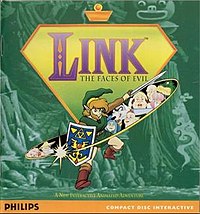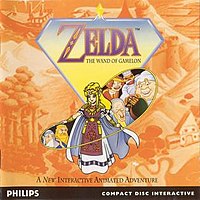Link: The Faces of Evil and Zelda: The Wand of Gamelon
|
Link: The Faces of Evil Zelda: The Wand of Gamelon |
|
|---|---|
 
Packaging for Link: The Faces of Evil and Zelda: The Wand of Gamelon. The artwork for Link and Zelda were reused promotional art from The Legend of Zelda: A Link to the Past.
|
|
| Developer(s) | Animation Magic |
| Publisher(s) | Philips Interactive Media |
| Distributor(s) | Nintendo |
| Director(s) | Dale DeSharone |
| Producer(s) | Dale DeSharone Stephen Radosh (executive) William Havlicek (audio) Igor Razboff (animation) |
| Designer(s) | Dale DeSharone (game) Rob Dunlavey (game, graphic, and production) Jonathan Merritt (game) Vasiliev A. (character) Smirnov V. (character) |
| Programmer(s) | Linde Dynneson John O'Brien John Wheeler |
| Artist(s) | Tom Curry (background paintings) Max Stienmetz (sprite) John Ursino (sprite) Rob Dunlavey (additional) |
| Writer(s) | Jonathan Merritt |
| Composer(s) | Tony Trippi William Havlicek |
| Series | The Legend of Zelda |
| Platform(s) | Philips CD-i |
| Release | |
| Genre(s) | Action-adventure |
| Mode(s) | Single-player |
Link: The Faces of Evil and Zelda: The Wand of Gamelon are two action-adventure video games developed by Animation Magic and published by Philips Interactive Media for the CD-i video game console. The two games were released at the same time, and look and play similarly due to their simultaneous development cycle and low budget. Another game was released for the CD-i, titled Zelda's Adventure, which featured a different developer and perspective than its predecessors.
Link: The Faces of Evil puts players in control of Link, while Zelda: The Wand of Gamelon has players control Princess Zelda. Both travel to a new world (Koridai and Gamelon respectively) to thwart Ganon's plans. Both games received positive reception at the time of release; however, both games, along with Zelda's Adventure, have become infamous with modern critics, which has led to the three games to be considered among the worst video games ever.
Players take control of Link in The Faces of Evil and Zelda in The Wand of Gamelon. In the beginning of both games, players have access to only three areas which are accessed through an in-game map. The two characters only have their swords and shields at this stage. The sword can be used to attack enemies either by stabbing or shooting "Power Blasts" while the shield can deflect attacks. The shield is used whenever the player-character is standing still or crouching. They gain new items later on in the game including lamp oil, rope, and bombs which can be purchased at a shop. Rubies (Rupees in canon Zelda games) can be obtained by stabbing them with the sword after defeating an enemy; after which they can be spent at the shop.
The player's health is measured in "Life Hearts". Although the player begins the game with only three hearts, there are ways to earn more. Each time the player-character is injured, they will lose at least one-half of a heart. The first two times the player-character runs out of Life Hearts, the player will be given the option of continuing from near the point where their last heart was lost. When the player-character loses their hearts for a third time, they will be returned to the map and the player will have to start the level from the beginning. Returning to the map replenishes their Life Hearts and lives and they will retain any items and rubies they picked up.
...
Wikipedia
